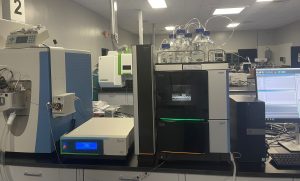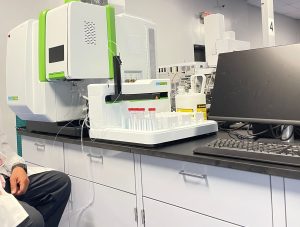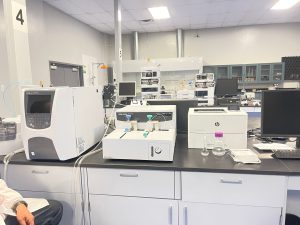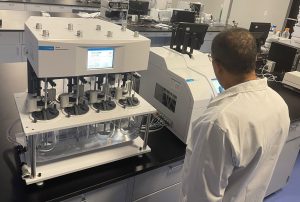- Home
- Analytical Chemistry
- Microbiology
- Pharmaceutical Development
- Clinical Research
- Consulting
Past Projects
Synergy Bioscience Past Projects
In Pursuit of Excellence: Recent Extractable/Leachable Study Reaffirms Our Commitment to Pharmaceutical Safety

Synergy Bioscience, a Contract Research Organization specializing in product development, analytical chemistry, microbiology testing, and quality system compliance consulting services, recently completed an important project that highlights our core expertise. We designed and executed an Extractables and Leachables (E&L) Study for medical-grade storage bags used to hold Active Pharmaceutical Ingredients (API) Concentrate. This study underscores our unwavering commitment to pharmaceutical safety.
Objective of the Study
The primary goal was to conduct a comprehensive E&L analysis to confirm the safety of API concentrates when stored in these medical grade bags. We aimed to identify and assess any substances that could potentially leach into the API concentrate from the bag’s material.
Initial Steps and Planning
The project began by identifying all elements of the storage system that could come into direct contact with the API concentrate, including the container, tubing, and other components. We created a customized E&L plan and a risk assessment matrix to evaluate the bags under various conditions.
Methodology and Testing
Utilizing a range of solvents with different polarities, controlled extraction studies were conducted. The extracted samples were rigorously analyzed, both qualitatively and quantitatively, and validated for accuracy, specificity, detection limits, and other key parameters.
Toxicological Evaluation
A separate phase of the project examined the safety aspects of the substances found in the study. We relied on extensive internal documentation to guide our evaluations, including pre-established guidelines for container closure systems and risk management strategies.
Tools and Team
Our study employed cutting-edge analytical tools such as Stability Chambers, Solvent Extractors, TOC, Orbitrap LC-MS/MS, GC-MS, IC-MS, and ICP-OES. An interdisciplinary team of seven internal and three external experts oversaw the project.
Key Findings
-
The in-depth study identified 21 potential substances that could leach into the API concentrate.
-
Calibration curves showed strong linearity and detection limits were confirmed at sub-ppm levels.
-
A detailed 157-page technical report was produced, summarizing the methodologies, findings, and safety assessments.
Conclusion
Our E&L study serves as a strong testament to Synergy Bioscience’s commitment to maintaining the highest safety standards in pharmaceuticals. It reaffirms our dedication to using advanced analytical methods and technologies to tackle pharmaceutical challenges. This project marks another milestone in our ongoing mission to be leaders in pharmaceutical safety and innovation. Join us as we continue to shape the future of healthcare, one groundbreaking project at a time.
THE DEVELOPMENT OF AN INHALATION DRUG PRODUCT

Showcasing one of our recent venture into developing an inhalation drug product: Sumatriptan. This case study delves into the creation of a generic inhalation combination product, amalgamating the power of inhalers with a Sumatriptan inhalation spray, aimed to revolutionize patient treatment experiences.
The first chapter of our journey revolves around the careful formulation of the drug product. Our expert team meticulously tailored the drug product to optimize its therapeutic efficacy. With a keen focus on assay content and the identification of potential degradants and impurities, we undertook a rigorous analytical testing process, ensuring the highest quality standards.
Understanding the importance of stability and consistency, we initiated a stability study for Sumatriptan, after developing the stability protocol and the procedure. We aimed to ascertain the longevity of the drug product, along with its reliability over time. Parallelly, content uniformity testing was employed, guaranteeing each dose dispensed through the inhalation spray maintains consistent drug content. This dual approach allowed us to verify the overall robustness of our product.
We adopted the Anderson Cascade Impactor method to assess the spray characteristics of Sumatriptan, particularly focusing on the symmetry and content uniformity of each inhaled spray. This verification process provided invaluable insights into the delivery system’s performance, ensuring optimal dosing for patients.
In addition to these strategies, we prioritized the microbiological safety of the product. Our team developed and validated extensive microbiology testing, ascertaining the safety profile of Sumatriptan, ensuring it is free from harmful microbial contaminants.
The culmination of our diligent efforts arrived after 11 months, when our sponsor received commercial approval for Sumatriptan from the FDA. This marked a momentous milestone in our product development journey, underscoring the success of our scientific strategies and the unwavering dedication of our team.
This case study encapsulates Synergy Bioscience’s commitment to creating revolutionary products by leveraging scientific expertise, innovative methodologies, and advanced technology. It reaffirms our potential to transform ideas into tangible treatments that enhance the quality of life for patients worldwide. Be a part of our journey, reach out to us, and discover how we can help you bring your vision to life.
FOSTERING INNOVATION IN ANTIBACTERIAL THERAPIES: A SYNERGY BIOSCIENCE CASE STUDY ON THE DEVELOPMENT OF A GENERIC DRUG
 Dive into a showcase of Synergy Bioscience’s prowess in transforming complex pharmaceutical challenges into triumphs. This journey reveals our collaboration with a client aimed at developing a generic drug to address a broad spectrum of bacterial infections, including skin and gynecological infections.
Dive into a showcase of Synergy Bioscience’s prowess in transforming complex pharmaceutical challenges into triumphs. This journey reveals our collaboration with a client aimed at developing a generic drug to address a broad spectrum of bacterial infections, including skin and gynecological infections.
Our first destination was the strategic enhancement of technological operation, production efficiency, and yield. We set our sights on perfecting the preparation method of a crucial beta-lactam inhibitor – tazobactam sodium. The process involved dissolving tazobactam acid in cooling water between 6-15°C, combining it with a salt-forming agent solution under meticulous temperature control, and subsequently lyophilizing to procure the desired tazobactam sodium powder.
In the pursuit of lasting stability, we prepared 4g of Tazobactam in 120mL of 5% dextrose (D5) under strictly aseptic conditions. This was stored for three months at -20°C, followed by thawing and maintaining for 58 days at a carefully controlled temperature of 5°C ± 3°C.
Our precision was then directed towards an instrumental task, the use of an HPLC instrument to measure tazobactam and piperacillin concentrations, employing the Agilent 1200 with a DAD detector. A dissolution profiling study was artfully designed and performed by our team, with organoleptic and spectrophotometric evaluations using our advanced dissolution apparatus, auto-sampler, and the Agilent HPLC 1200.
Investigating further, our experts microscopically examined the particles post-reconstitution and after standing for 4 hours at laboratory temperature. The chemical stability assessment involved the strategic use of HPLC. By optimizing processing conditions, we managed to significantly boost the total yield of the target product to a notable 37.09% (30.93% in batch), enhancing procedure safety in the process.
The culmination of our unwavering efforts arrived just eight months post-ANDA application filing when our client successfully secured FDA approval for the generic drug’s commercialization.
This journey underscores Synergy Bioscience’s dedication and scientific expertise in drug product development, highlighting our ability to transform pharmaceutical visions into successful, market-ready products. Step into the future of pharmaceutical development with us and experience the Synergy difference.
Synergy Bioscience and the Art of Overcoming Challenges: A Case Study in Aminoglycoside Antibiotic Development
 Welcome to one of the exploration of Synergy Bioscience’s pharmaceutical ingenuity – We are spotlighting our involvement in the development of an aminoglycoside antibiotic for severe bacterial infections. Our story unfolds as we harnessed our scientific acumen and innovative techniques to overcome daunting challenges, bringing a powerful antibacterial solution to life.
Welcome to one of the exploration of Synergy Bioscience’s pharmaceutical ingenuity – We are spotlighting our involvement in the development of an aminoglycoside antibiotic for severe bacterial infections. Our story unfolds as we harnessed our scientific acumen and innovative techniques to overcome daunting challenges, bringing a powerful antibacterial solution to life.
The drug product in this study demonstrated its bacterial activity effectively when delivered using Two APIs coated with zinc oxide nanoparticles (ZnO NPs). Our adept team meticulously scrutinized this potent antibacterial interaction, harnessing the power of these nanoparticles for an optimal therapeutic outcome.
Pioneering advances in the pharmaceutical technology at our disposal allowed us to dramatically enhance the development and laboratory scale production process. We succeeded in purifying and isolating the drug from impurities, slashing the duration from a conventional 120-135 hours down to an impressive 17 hours. Not only did this ensure the drug’s high reproducibility, but it also significantly boosted the yield of the target product, elevating it from 37-40% to a noteworthy 60-65%.
Next, we turned our attention to the critical factors of product stability (shelf life) and biocompatibility compatibility studies. In-depth analysis was conducted at 1 mg/ml and 0.2 mg/ml concentrations over 24 and 48-hour periods at 25°C. Our meticulous approach assured us of the drug’s enduring efficacy and safety.
We subsequently leveraged a reversed-phase (RP)-LC method, employing a mobile phase containing per-fluorinated ion-pair coupled with our most advanced Orbitrap mass spectrometer for comprehensive chemical characterization of the product. This involved the use of other advanced instruments, including GC-MS, to deliver a detailed, accurate profile of the product.
Delving deeper, we embarked on a dissolution study to investigate the in vitro drug release characteristics of the drug product two APIs. These were spectrophotometrically determined by measuring absorbance using our state-of-the-art dissolution apparatus (Agilent 708-DS Dissolution Apparatus and 850-DS Sampling Station). The apparatus, equipped with an auto-sampler, ensured full compliance with 21 CFR Part 11 requirements.
The grand finale came seven months into our journey when our client received the approval to commence drug manufacturing. This case study is more than just a success story; it stands as an affirmation of Synergy Bioscience’s commitment to excellence and our unwavering determination to drive pharmaceutical innovation. Experience the future of drug development with us, and together let’s transform the face of healthcare.
Unveiling the Potential of Innovative Drug Development with Synergy Bioscience: A Case Study in Peptic and Duodenal Ulcer Treatment

Synergy Bioscience prides itself on bolstering scientific advancement within the pharmaceutical industry. One of our most recent achievement showcases our ability to accelerate drug product development, surpassing technical hurdles to drive our client’s success. Here’s a journey into our collaborative efforts in bringing an innovative solution for peptic and duodenal ulcer treatment to the forefront.
Our client reached out to us during a challenging phase of their product formulation. Keen to expedite the development of their drug product, they sought our scientific expertise and developmental support. Without delay, we set sail on this pharmaceutical voyage, fully dedicated to transforming the challenges into rewarding outcomes.
Our initial step involved a comprehensive review of the pre-formulation studies. Through careful scrutiny, we evaluated the physical and chemical properties of the drug, both in isolation and in combination with various excipients. Following this, an analytical method was devised for the Active Pharmaceutical Ingredient (API) using the Orbitrap LC-MS/MS technique.
To enhance the drug product’s homogeneity, we ingeniously prepared the drug substane-loaded nanoparticles using a polylactide acid (PLA) polymer backbone grafted with Polyethylene Glycol (PEG), at a 1.5% molar ratio. To ascertain the new formulations’ shelf-life, freshly sealed vials were stored in a stability chamber set at 25°C ±2°C with 60% relative humidity.
The mixture of the drug substance (API), HPMC polymer, sodium bicarbonate, and lactose was next. It was masterfully combined on a molten mass. We then moved onto the scale-up study, employing a sophisticated fluidized-bed granulator operating at a rotation speed of 1500 rpm. Select formulations were then subject to a 90-day stability test under controlled temperature and moisture conditions, maintained at 40±5°C and 70±2% humidity, respectively.
In parallel with these rigorous activities, our dedicated QA/RA team prepared and submitted an abbreviated new drug application (ANDA). The application was meticulously backed by statistical analysis to establish bioequivalence with the brand-name drug, along with other essential validation information.
We are proud to report that, within just nine months, our client’s drug product received the regulatory approval for manufacturing and commercialization. It’s not just a testament to our client’s vision but a striking example of how Synergy Bioscience turns scientific challenges into remarkable breakthroughs in drug product development. This journey stands as a testament to our unwavering dedication, scientific prowess, and innovative approach. Welcome to the future of pharmaceuticals with Synergy Bioscience.
Batch Record Reviews
 After receiving an FDA Warning Letter, a well-known pharmaceutical company requested from Synergy to get involved in the remediation of their warning letter. Part of the warning letter remediation efforts was related to several thousands of product manufacturing Batch Records reviews. We started the work by verifying the calibration records, NCRs/Deviations, OOS investigations, and the in-process data. Based on our review process, we presented our conclusions and recommendations to the executive management. Our recommendations were instrumental in highlighting the need to establish a mechanism to separate between their R&D and the QC laboratory activities and building a new and separate R&D laboratory, as this lied at the heart of the root cause behind the warning letter. Our success in this project was a factor in having the management extend the scope of the project for Synergy.
After receiving an FDA Warning Letter, a well-known pharmaceutical company requested from Synergy to get involved in the remediation of their warning letter. Part of the warning letter remediation efforts was related to several thousands of product manufacturing Batch Records reviews. We started the work by verifying the calibration records, NCRs/Deviations, OOS investigations, and the in-process data. Based on our review process, we presented our conclusions and recommendations to the executive management. Our recommendations were instrumental in highlighting the need to establish a mechanism to separate between their R&D and the QC laboratory activities and building a new and separate R&D laboratory, as this lied at the heart of the root cause behind the warning letter. Our success in this project was a factor in having the management extend the scope of the project for Synergy.
In the second phase of the project, Synergy team of chemists, scientists, and a regulatory compliance specialist performed Analytical Method Transfer Gap Assessment for 137 analytical methods. The outcome of the gap assessment was a determination that the methods were not properly validated according to approved protocols or compendial specifications. So, Synergy embarked on a collaborative effort to optimize these test methods using chromatographic and spectrometric techniques, by writing and executing the validation protocols for those methods that don’t have a proof of validation documentation. These analytical methods included HPLC, LC-MS/MS, GC, GC-MS, ICP-MS, TOC, among many others. Writing the validation protocols, Work Instructions, executing the validation and transferring these test methods to the QC laboratories took 3 years.
Chemistry Lab Operation
 A CRO/CMO pharmaceutical start up requested from Synergy to help with the set up and initial operation of their chemistry laboratory to support in the development and manufacturing of generic drug products. We started our collaboration effort by commissioning and qualifying the needed analytical instruments (HPLC, GC, TOC, etc.) and their related LIM System Software (Agilent OpenLab Software) as well as providing training and mentoring to the technical staff. Then, we worked on establishing the development strategy for the first three generic drug products the company wanted to start with. After that, we worked on developing the formulation study for the first drug product. During the formulation development, a dissolution variation problem caused by a complex relationship between process variables and raw material properties presented itself. Using the concept of Design of Experiment (DOE), we were able to identify key interactions between raw materials and process variables. This effort helped us identify the need to tighten raw material specifications to establish a bio equivalency between the generic formulation and the brand name drug product formulation.
A CRO/CMO pharmaceutical start up requested from Synergy to help with the set up and initial operation of their chemistry laboratory to support in the development and manufacturing of generic drug products. We started our collaboration effort by commissioning and qualifying the needed analytical instruments (HPLC, GC, TOC, etc.) and their related LIM System Software (Agilent OpenLab Software) as well as providing training and mentoring to the technical staff. Then, we worked on establishing the development strategy for the first three generic drug products the company wanted to start with. After that, we worked on developing the formulation study for the first drug product. During the formulation development, a dissolution variation problem caused by a complex relationship between process variables and raw material properties presented itself. Using the concept of Design of Experiment (DOE), we were able to identify key interactions between raw materials and process variables. This effort helped us identify the need to tighten raw material specifications to establish a bio equivalency between the generic formulation and the brand name drug product formulation.
In parallel with these activities, our scientists worked with the client’s technical team on developing and validating analytical methods for the drug products, establishing their Stability Indicating Studies, performing dissolution studies, as well as identified and quantified degradation components and profiling any residual solvents of the drug substances. Then, we developed and validated an analytical method for identifying and quantifying class III residual solvents and calculated the DPE limits for each solvent. The work for the first drug product was completed successfully and on time and was approved by the FDA. The client still has an ongoing relationship with Synergy, and we are still involved in drug development activities for them.
Cleaning Validation
 As part of their cGMP facility operation readiness, a client of ours requested that we develop and validate a cleaning validation program to support their development and manufacturing activities of drug products that are in their late development stages. Using the Design of Experiment (DOE), we started by developing a master validation plan for sterilized processes (aseptic processing). After that, we developed the cleaning validation process map, the characterization of the residuals of drug products. Then, we performed the recovery studies and authored the cleaning process SOP and the validation protocols, followed by providing training to the client’s technical staff on how to ensure successful completion of the protocols. Then, we monitored their performance while executing the protocols to ensure compliance with the established procedures.
As part of their cGMP facility operation readiness, a client of ours requested that we develop and validate a cleaning validation program to support their development and manufacturing activities of drug products that are in their late development stages. Using the Design of Experiment (DOE), we started by developing a master validation plan for sterilized processes (aseptic processing). After that, we developed the cleaning validation process map, the characterization of the residuals of drug products. Then, we performed the recovery studies and authored the cleaning process SOP and the validation protocols, followed by providing training to the client’s technical staff on how to ensure successful completion of the protocols. Then, we monitored their performance while executing the protocols to ensure compliance with the established procedures.
Using Synergy’s in-house state of the art analytical capabilities, we performed the TOC analysis of the collected samples, analyzed and tabulated the results of rinse and swab sampling, and then wrote the summary report of the cleaning validation study, so it can be included in the CMC section of the drug filing applications. From start to finish, the project took only 4 months. This is a record time to complete a project of this nature in such a short amount of time. It is also a clear testimony that relying on professionals who have the expertise and the technical know-how can save you time and money and protect your business from regulatory noncompliance risk.
Bio Process Validation
 A biopharmaceutical company requested from Synergy to work with their engineering department and help in the optimization and revalidation of their manufacturing process of a therapeutic protein drug product. To integrate the upstream process with the downstream one, we did a re-validation of the downstream process of a monoclonal antibody and performed chromatographic HPLC analysis for samples from different phases such as biomass product separation, product purification, concentration, crystallization, drying and fill-finish among other activities. Along with this effort, there were concurrent effort for optimizing and re-validating the chromatographic testing methods for identification and quantitation of the therapeutic protein molecule in biological samples. After revalidating these methods, they proved to be specific, accurate, and precise and were used throughout the entire processing program. In addition, we got involved in the development and validation of a therapeutic protein lyophilization (freeze-dry) study for another product, by establishing and optimizing the lyophilization parameters (shelf temperature, chamber pressure, drying times, and end point). This study served as a precursor of process development and validation for the commercial processing.
A biopharmaceutical company requested from Synergy to work with their engineering department and help in the optimization and revalidation of their manufacturing process of a therapeutic protein drug product. To integrate the upstream process with the downstream one, we did a re-validation of the downstream process of a monoclonal antibody and performed chromatographic HPLC analysis for samples from different phases such as biomass product separation, product purification, concentration, crystallization, drying and fill-finish among other activities. Along with this effort, there were concurrent effort for optimizing and re-validating the chromatographic testing methods for identification and quantitation of the therapeutic protein molecule in biological samples. After revalidating these methods, they proved to be specific, accurate, and precise and were used throughout the entire processing program. In addition, we got involved in the development and validation of a therapeutic protein lyophilization (freeze-dry) study for another product, by establishing and optimizing the lyophilization parameters (shelf temperature, chamber pressure, drying times, and end point). This study served as a precursor of process development and validation for the commercial processing.
Concurrent with this effort, Synergy’s team was involved in the optimization of the Quality Management System (QMS), providing GMP training, compiling the Biologic License Application which included sections for Establishment Description, Safety/Purity/Potency, Chemistry (CMC), Summary Report, and preparing the facility for FDA Pre-Approval Inspection. Along the line with these activities, our team of consultants were involved in the assessment and remediation of a manufacturing processes and its related quality system, as per 21 CFR 211 and 21 CFR 610 regulations, of a biopharmaceutical company manufacturing drug product. We were also able to provide practical solutions to mitigate and optimize the following processes: Producess and Production Controls for aseptic manufacturing, which included Packaging and Labeling Controls, Master production record, Validation protocols/reports, manufacturing equipment qualifications (IQ/OQ/PQ), and manufacturing process validation. The team’s efforts helped in the reduction of manufacturing related deviations, OOS, and CAPAs, which led to the improvement of the process outcome from about the 3 Sigma level to the needed 6 Sigma level. Also, we were able to reduce the time required for the required biannual verification of the manufacturing process validation from over 4700 hours to less than 2500 hours. The company passed the FDA inspection with no audit findings and shipped the first shipment valued at over $68M.
cGMP Facility Transfer
 A medical device company, developer and manufacturer of implantable class III medical devices, hired us to help in one of their cGMP facilities transfer. The project scope included the transfer of the manufacturing equipment and their related processes such as real-time control/manufacturing automation systems. Our team started the qualification process of newly designed ISO Class 7 cleanroom suite by performing the validation studies for the cleanroom (as built, at rest, and operational) as well as their related utilities, and rewriting and implementing the equipment re-qualification protocols (IQ/OQ/PQ) for equipment/processes as well as re-writing SOPs for three lines of manufacturing (37 pieces of equipment) and completing the technical summary reports.
A medical device company, developer and manufacturer of implantable class III medical devices, hired us to help in one of their cGMP facilities transfer. The project scope included the transfer of the manufacturing equipment and their related processes such as real-time control/manufacturing automation systems. Our team started the qualification process of newly designed ISO Class 7 cleanroom suite by performing the validation studies for the cleanroom (as built, at rest, and operational) as well as their related utilities, and rewriting and implementing the equipment re-qualification protocols (IQ/OQ/PQ) for equipment/processes as well as re-writing SOPs for three lines of manufacturing (37 pieces of equipment) and completing the technical summary reports.
As part of the project execution, there were numerous software platforms that required validation and testing as part of developing and executing system life cycle deliverables (URS, SRS, FRS, DDS, RTM, Unit Integration, User Acceptance testing, Delta V, FAT, SAT, Validation Planning, IQ, OQ, PQ, Final Validation Summary Report) as per 21 CFR Part 11 and provided training and mentoring to the technical staff. Getting this project done on time was not only critical for the client to bring the entire transfer project back on schedule but to bring the product inventory level to a safe one as well.
Supplier Quality Audit
 A well-known biotechnology company requested from Synergy to review and improve their Supplier Quality Management system. The review process led to recommendations for the need to implement significant number of improvements and the need to revalidate their Supplier Quality software (Master Control). Then, we were asked to develop and execute a plan to perform audits to their large and diversified network of suppliers. A total of 53 supplier audits for their supply chain were performed in less than a year. The outcome of these audits resulted in numerous audit observations, some of them were critical. To close the audit reports, these observations required to be addressed first but some of the suppliers were resisting any changes. Our effort resulted in successfully persuading these suppliers to address these compliance issues which were overlooked during previous audits. Initially, the suppliers were reluctant to address them because they were supplying other companies and their clients never raised any issue with their products.
A well-known biotechnology company requested from Synergy to review and improve their Supplier Quality Management system. The review process led to recommendations for the need to implement significant number of improvements and the need to revalidate their Supplier Quality software (Master Control). Then, we were asked to develop and execute a plan to perform audits to their large and diversified network of suppliers. A total of 53 supplier audits for their supply chain were performed in less than a year. The outcome of these audits resulted in numerous audit observations, some of them were critical. To close the audit reports, these observations required to be addressed first but some of the suppliers were resisting any changes. Our effort resulted in successfully persuading these suppliers to address these compliance issues which were overlooked during previous audits. Initially, the suppliers were reluctant to address them because they were supplying other companies and their clients never raised any issue with their products.
CAPA Process
 A well know medical devices company was under Consent Decree and in desperate need of special expertise to help them get out of it sooner so they can resume their business. So, they contacted Synergy and we dispatched 22 of our consultants to expedite their remediation effort. Several of their business processes had compliance issues and we were asked to start with the Corrective Action/Preventive Action (CAPA) process. The initial review showed the need to overhaul the entire CAPA process, build a new one, and provide extensive training to the entire organization as part of organization cultural change, which we were successful in doing. Then, we started clearing of a very large backlog of open CAPA records, some of them were as old as 3 years back. As part of this effort, we had to validate the EtQ software platform and mentor the CAPA investigators on how to properly investigate for identifying and confirming root causes, using the quality risk management as the basis for their investigation. Furthermore, optimizing the CAPA process and clearing the backlog exposed other processes that needed our immediate attention as well, such as product complaint handling and manufacturing process nonconformance investigations. To ensure sustainable compliance of the company’s quality system, we had to improve the internal audit program of the organization and mentor the company’s internal auditors while performing their internal audits. Then, we moved to prepare the company for the next FDA recertification inspection. Our effort helped the company get out of their consent decree after only 19 months from our involvement date.
A well know medical devices company was under Consent Decree and in desperate need of special expertise to help them get out of it sooner so they can resume their business. So, they contacted Synergy and we dispatched 22 of our consultants to expedite their remediation effort. Several of their business processes had compliance issues and we were asked to start with the Corrective Action/Preventive Action (CAPA) process. The initial review showed the need to overhaul the entire CAPA process, build a new one, and provide extensive training to the entire organization as part of organization cultural change, which we were successful in doing. Then, we started clearing of a very large backlog of open CAPA records, some of them were as old as 3 years back. As part of this effort, we had to validate the EtQ software platform and mentor the CAPA investigators on how to properly investigate for identifying and confirming root causes, using the quality risk management as the basis for their investigation. Furthermore, optimizing the CAPA process and clearing the backlog exposed other processes that needed our immediate attention as well, such as product complaint handling and manufacturing process nonconformance investigations. To ensure sustainable compliance of the company’s quality system, we had to improve the internal audit program of the organization and mentor the company’s internal auditors while performing their internal audits. Then, we moved to prepare the company for the next FDA recertification inspection. Our effort helped the company get out of their consent decree after only 19 months from our involvement date.